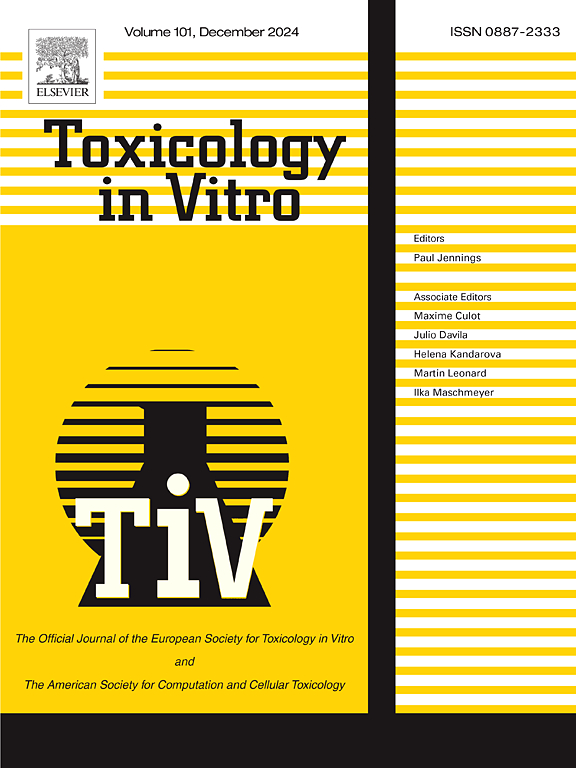Testing chemicals for CYP19 inhibition: Comparison of a modified H295R steroidogenesis assay to a commercial fluorometric enzyme inhibition kit
IF 2.6
3区 医学
Q3 TOXICOLOGY
引用次数: 0
Abstract
Aromatase (CYP19A1) is a key enzyme that converts androgens to estrogens. Given its central role in estrogen biosynthesis, aromatase is a target of endocrine disruption. Aromatase disruption can be measured in vitro with cell-free enzyme assays or using cells expressing CYP19A1. Results may vary between models, as cell-based models can have adaptive responses not present in enzyme assays. Here, we have compared 21 chemicals for their ability to affect aromatase by direct and indirect disruption using an aromatase commercial kit and a modified H295R steroidogenesis assay. New data was generated for eighteen test compounds in either one or both of the models. Chemicals eliciting a response could be divided into five categories: 1) substances that decreased the response in both models, 2) substances that directly inhibited aromatase, but increased 17β-estradiol (E2) levels in H295R assay, 3) substances that directly inhibited aromatase, but did not affect E2 levels in H295R assay, 4) substances that did not inhibit aromatase activity, but increased E2 levels in the H295R model, and 5) substances that did not alter responses in either of the assays. These results illustrate that both assays are useful for assessing the potential of chemicals to affect E2 levels either through direct aromatase inhibition or other indirect mechanisms.
检测CYP19抑制的化学物质:改良的H295R甾体生成试验与商业荧光酶抑制试剂盒的比较。
芳香化酶(CYP19A1)是将雄激素转化为雌激素的关键酶。鉴于其在雌激素生物合成中的核心作用,芳香化酶是内分泌干扰的目标。芳香酶破坏可以通过体外无细胞酶测定或使用表达CYP19A1的细胞来测量。模型之间的结果可能有所不同,因为基于细胞的模型可能具有酶分析中不存在的适应性反应。在这里,我们比较了21种化学物质通过直接和间接破坏芳香化酶的能力,使用芳香化酶商业试剂盒和改进的H295R甾体生成试验。在一种或两种模型中产生了18种测试化合物的新数据。引起反应的化学物质可分为五类:1)在两种模型中均降低反应的物质;2)直接抑制芳香化酶,但在H295R实验中增加17β-雌二醇(E2)水平的物质;3)直接抑制芳香化酶,但在H295R实验中不影响E2水平的物质;4)不抑制芳香化酶活性,但在H295R模型中增加E2水平的物质;5)在两种实验中均不改变反应的物质。这些结果表明,这两种分析方法都可用于评估化学物质通过直接芳香化酶抑制或其他间接机制影响E2水平的潜力。
本文章由计算机程序翻译,如有差异,请以英文原文为准。
求助全文
约1分钟内获得全文
求助全文
来源期刊

Toxicology in Vitro
医学-毒理学
CiteScore
6.50
自引率
3.10%
发文量
181
审稿时长
65 days
期刊介绍:
Toxicology in Vitro publishes original research papers and reviews on the application and use of in vitro systems for assessing or predicting the toxic effects of chemicals and elucidating their mechanisms of action. These in vitro techniques include utilizing cell or tissue cultures, isolated cells, tissue slices, subcellular fractions, transgenic cell cultures, and cells from transgenic organisms, as well as in silico modelling. The Journal will focus on investigations that involve the development and validation of new in vitro methods, e.g. for prediction of toxic effects based on traditional and in silico modelling; on the use of methods in high-throughput toxicology and pharmacology; elucidation of mechanisms of toxic action; the application of genomics, transcriptomics and proteomics in toxicology, as well as on comparative studies that characterise the relationship between in vitro and in vivo findings. The Journal strongly encourages the submission of manuscripts that focus on the development of in vitro methods, their practical applications and regulatory use (e.g. in the areas of food components cosmetics, pharmaceuticals, pesticides, and industrial chemicals). Toxicology in Vitro discourages papers that record reporting on toxicological effects from materials, such as plant extracts or herbal medicines, that have not been chemically characterized.
 求助内容:
求助内容: 应助结果提醒方式:
应助结果提醒方式:


